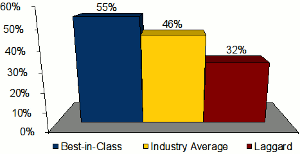
All mobile software applications (“apps”) are not created equal.
Enterprise end-users have a fundamentally different expectation of their mobile apps than they do of their desktop apps. They expect rapid and easy access to secure and accurate information whenever and wherever it’s needed.
The impact of biomechanical factors engendered by the use of a smartphone or tablet computer while in motion, standing or seated in public spaces is very different from the impact of using a laptop or desktop computer while seated in a cubicle, conference room or office. As a result, a different approach to user interface (UI) and user experience (UX) design is required.
Short, interrupt-driven information “grazing” demands simplified graphical interfaces, with gesture-based touchscreens. Tight, focused, task-driven “applets” trump large application suites, which are mired in modal menus and cascading interfaces.
This article highlighting Aberdeen’s upcoming study will focus on these “Mobile Apps 2.0” for smartphones and tablet computers, as they are used “in motion” — as contrasted with netbooks and laptops, which are mobile but used “at rest” at a desk or conference table.
Beyond Enterprise Mobile Software 1.0
In the May 2010 Aberdeen study “Enterprise Mobility Management: Optimizing the Full Mobile Lifecycle,” just over half of the Best-in-Class realized the competitive advantage that enterprise-grade mobile software can provide; and they develop that software in-house.
The Best-in-Class in that study didn’t develop their mobile infrastructure just to deliver corporate email; their mobile ecosystem is also capable of delivering real-time information wherever and whenever it’s needed, for a variety of functional groups. Their mobile infrastructure supports their competitive differentiation by automating redundant processes and streamlining communications and workflow, making the organization more operationally efficient, responsive and flexible.
Aberdeen’s upcoming study expects to find the Best-in-Class adopting new models for their mobile software which are distinctly different from the models of the recent past. No longer confined to either mobile e-mail or middleware-enabled bridges to back-end enterprise software suites such as salesforce automation (SFA) or enterprise resource management (ERP), the emerging mobile software model scrapes highly targeted information from wherever the data may reside, be it behind the corporate firewall or across the public or private cloud. These new lightweight applications are particularly adept at delivering task-specific information exactly where and when information is needed, at “the point of decision.”
Mobile Apps 2.0
The “real-time enterprise” (RTE) is focused on market and customer responsiveness, swift and agile decision-making, and transparency and immediacy of information. Enterprise mobility is an essential enabler of the RTE, delivering business-critical information when and where it’s needed. Enterprise mobility allows RTEs to capitalize on the competitive pressure in increasingly global markets and turn that pressure into their advantage.
Mobile access to this business-critical information is made possible by mobile software applications (apps). As contrasted with consumer mobile apps, enterprise-grade mobile apps deliver secure, anytime access to up-to-date business information, beyond corporate email and personal information management (PIM) data, the RTE relies on mobile applications such as ERP, business intelligence dashboards and customer, inventory or sales data. Top-performing organizations deploy these enterprise-grade apps across their organization, providing a competitive advantage as they decrease the cost of sales, increase responsiveness and customer loyalty, and remain flexible and agile to accommodate swift market changes.
New Mobile Application and Data Delivery Models
This new mobile software model is no longer about trying to cram as much legacy functionality as possible into the smallest possible screen real estate. It’s about leveraging mobility to redesign workflow and communications processes, and deliver actionable information on-demand when and where it is needed.
The mobile Internet, which is already a reality on the BlackBerry, Android, iOS, Windows Phone, webOS and Symbian mobile platforms, is the common denominator of this new generation of mobile apps, “Mobile Apps 2.0.”
Andrew Borg is a senior research analyst for wireless and mobility at Aberdeen Group.


















































Social Media
See all Social Media